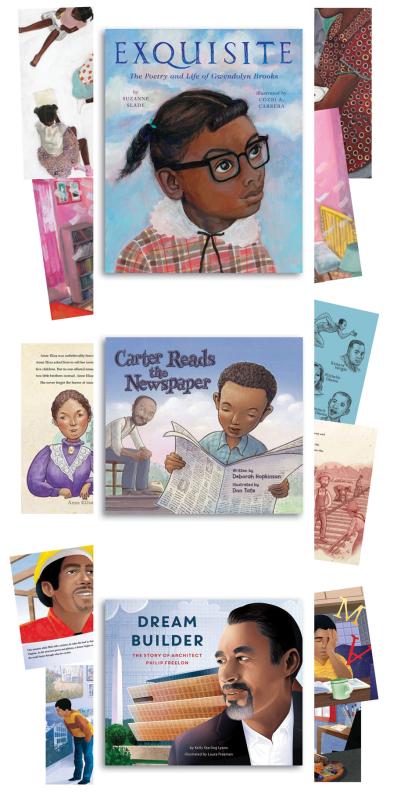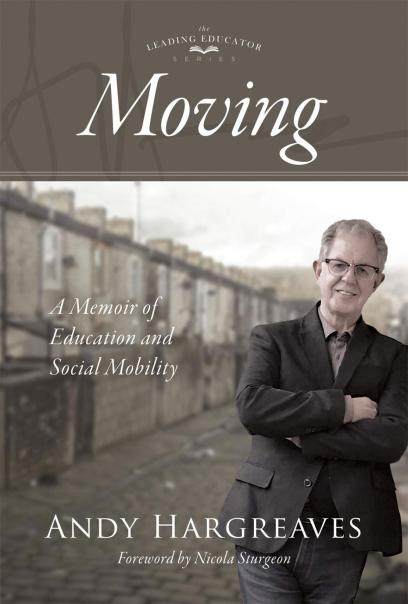Picture-Book Biographies of Black American Leaders
Elementary-grades educators seeking to supplement their lessons on the contributions of Black Americans may want to consider three recent picture-book biographies of poet Gwendolyn Brooks, historian Carter G. Woodson, and architect Philip Freelon. Their stories are told with rich visual details sure to inspire children to follow their dreams.
In Exquisite: The Poetry and Life of Gwendolyn Brooks (Abrams Books for Young Readers), written by Suzanne Slade and illustrated by Cozbi A. Cabrera, readers learn about the first Black person to win a Pulitzer Prize. Colorful pictures show Brooks growing up in Chicago in the 1920s in a loving family without much money but with a deep appreciation for poetry. The book’s opening pages show a young girl, lost in a book of poems, seated next to her family’s bookcase filled with what Slade calls “great treasure.” Filling notebooks with poems, Brooks “carefully strung words together like elegant jewels in perfect meter and time.” Readers watch as she hones her craft in college and as a young wife and mother, until after years of perseverance, her poems are published, earning the recognition she deserves.
While Brooks made her name in literature, Carter G. Woodson pursued his passion in African American history. Carter Reads the Newspaper (Peachtree), written by Deborah Hopkinson and illustrated by Don Tate, tells how a determined boy from Virginia grew up to become the “father of Black history.” As a child, Woodson’s interest in learning was kindled by reading the newspaper to his father, who was illiterate. Woodson eventually earned a PhD in history from Harvard University and was the second African American to do so after W. E. B. Du Bois. In 1926, Woodson created Negro History Week, which later became Black History Month.
The lives of many Black Americans celebrated and honored during that month are spotlighted at the Smithsonian’s National Museum of African American History and Culture. In fact, the museum’s lead architect, Philip Freelon, was himself a famous Black American. Dream Builder: The Story of Architect Philip Freelon (Lee & Low Books), written by Kelly Starling Lyons and illustrated by Laura Freeman, tells how a boy from Philadelphia loved to draw. That love propelled him to pursue architecture in college, where “he wonders why they never study anything created by people who look like him.” When teachers read Dream Builder to students, the next Philip Freelon no longer has to ask such a question.
Moving: A Memoir of Education and Social Mobility
At a time of rising inequality, we must redouble our efforts to ensure that all children have access to educational opportunities that help them reach their potential. That’s the heart of Moving: A Memoir of Education and Social Mobility (Solution Tree Press) by Andy Hargreaves, an emeritus professor of education at Boston College.
Growing up in a working-class family in the 1950s and 1960s in Accrington, a small town in northern England, Hargreaves faced many struggles. Tragedy struck when Hargreaves was 12; his father died suddenly, and his mother and two older brothers endured emotional and financial hardships. But with the help of his family, his community, and his school, Hargreaves learned to thrive. Hargreaves credits the educational opportunities he received and the caring teachers he encountered with helping to propel him to a successful career and an upper-middle-class life. And he acknowledges his good fortune to grow up and attend school at a time when economic inequality was far less pervasive.
Still, he sees that others did not have as many opportunities or supports as he did. That’s why Hargreaves devotes the last part of his book to steps society can take to advance an “equity and mobility agenda.” These steps include public investments in welfare benefits, like the kind his mother received when she struggled to cope with raising her sons, and funding for education so that public schools aren’t starved of resources and can fully support students, families, and the common good.
Just as important, Hargreaves addresses something that has been more widely acknowledged in the wake of protests against systemic racism: the need for equity in student learning. “Equity isn’t just about equalizing test scores or narrowing achievement gaps in literacy and mathematics,” he writes. “It is about getting all students to succeed, whatever their backgrounds, by making them feel and be included in their schools, their curricula, and their learning.”


